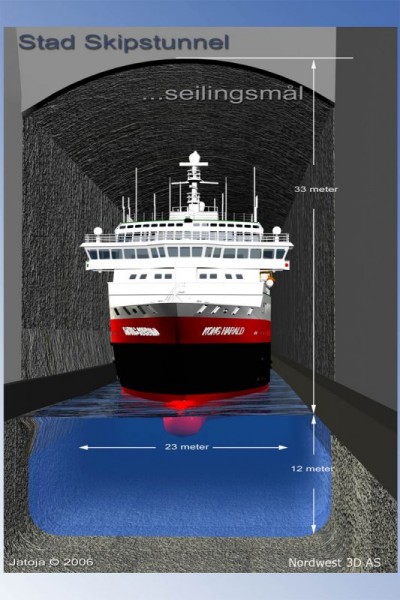Ship tunnel plan sails forward
January 28, 2013
Plans for a huge tunnel for ships at Norway’s stormy West Cape might finally be given the go-ahead this spring. It would be the first such tunnel in the world and could become a major tourist attraction, but critics blast the project as being a fantasy without social merit.

Civic boosters at Stad on Norway’s northwest coast have long promoted the idea of a building a tunnel for ships, so they could avoid stormy seas around the West Cape. They’re not giving up. PHOTO: skipstunnel.no
If approved, reports newspaperAftenposten, the tunnel will be built at Stad in the county of Sogn and Fjordane on Norway’s west coast. The stretch of sea along this northern part of the west coast, and around the West Cape, is notoriously treacherous for ships. The idea of building a tunnel here has been in the development stages since the 1980s.
The seas around the Stad peninsula have historically been plagued by strong winds and shipwrecks, and are one of the main obstacles preventing a fast-ferry passenger route between Bergen and Ålesund. A tunnel built at the narrowest point connecting the Stad/West Cape peninsula to the mainland would allow ships to pass through safely, and to run on time. Its supporters say the tunnel could become a tourist attraction in its own right, and give a boost to local industry and business.
The proposed tunnel would even be big enough for Hurtigruten, the coastal passenger and cargo shipping line that runs along the Norwegian coast, to pass through. The projected route for the tunnel would be at the narrowest and innermost point of the peninsula, between Moldefjorden and Kjødepollen in Selje municipality. Its cost is estimated to be NOK 1.7 billion.
‘New era’ for coastal shipping
Selje Mayor Ottar Nygård believes there are many good reasons for building the tunnel, and that it would herald a new era for the region.
Selje Mayor Ottar Nygård believes there are many good reasons for building the tunnel, and that it would herald a new era for the region.
“It will increase safety and regularity,” he told Aftenposten. “Today ships have to wait when there is bad weather, and that’s an obstacle to good regularity. The tunnel will also help us move goods from land to sea, and that will become even more important in the future, as the farming industry grows.”
Critics, however, say there is no longer any need for the tunnel. Whereas boats used to be smaller and passed closer to land, where the sea is most dangerous, they are now bigger and safer, and travel further out to sea, they argue.
“Serious shipping accidents belong to history,” writes Professor Knut Samset, who is the leader of the programme Concept at the Norwegian University of Science and Technology (Norges teknisk-naturvitenskapelige universitet, NTNU) in Trondheim. The programme, with backing from the Ministry of Finance, particularly researches the outcome of large-scale state investments.
An idea that won’t die
Samset criticizes the project for having grown bigger and bigger over the years. The original proposal in 1984 was for a tunnel which could accommodate vessels of up to 600 gross tonnes. When it was not approved, it grew larger. In 2001 it could accommodate vessels up to 5000 gross tonnes, and in 2007 up to 16000 gross tonnes (the equivalent of Hurtigruten‘s largest passenger ship).
Samset criticizes the project for having grown bigger and bigger over the years. The original proposal in 1984 was for a tunnel which could accommodate vessels of up to 600 gross tonnes. When it was not approved, it grew larger. In 2001 it could accommodate vessels up to 5000 gross tonnes, and in 2007 up to 16000 gross tonnes (the equivalent of Hurtigruten‘s largest passenger ship).
“The striking thing is that each time the state rejects the proposal, local interested parties come back with a new suggestion, another approach and a different argument, but the concept is the same, just in a bigger format,” he wrote in a newsletter for the research programme. “Even more remarkable is that the state apparently takes this at face value each time, and allows the dice to roll yet again.”
One of the conditions, in order for the project to get approval, is that it will be of benefit to society in general. Successive governments have commissioned reports on the tunnel, and independent experts have repeatedly come up with the assessment that it will not be of use to society. A new set of experts, however, has now concluded that the tunnel will bring economic benefits.
The government has now set aside NOK 200 million in its transport plan for the period 2010-2019 towards planning for the tunnel. The answer this time to whether it will be built will come in the spring, when the government presents its National Transport Plan.
Views and News from Norway/Elizabeth Lindsay
No comments:
Post a Comment